Cite this document
(Introduction to accounting Coursework Example | Topics and Well Written Essays - 2000 words, n.d.)
Introduction to accounting Coursework Example | Topics and Well Written Essays - 2000 words. https://studentshare.org/finance-accounting/1819761-introduction-to-accounting
Introduction to accounting Coursework Example | Topics and Well Written Essays - 2000 words. https://studentshare.org/finance-accounting/1819761-introduction-to-accounting
(Introduction to Accounting Coursework Example | Topics and Well Written Essays - 2000 Words)
Introduction to Accounting Coursework Example | Topics and Well Written Essays - 2000 Words. https://studentshare.org/finance-accounting/1819761-introduction-to-accounting.
Introduction to Accounting Coursework Example | Topics and Well Written Essays - 2000 Words. https://studentshare.org/finance-accounting/1819761-introduction-to-accounting.
“Introduction to Accounting Coursework Example | Topics and Well Written Essays - 2000 Words”. https://studentshare.org/finance-accounting/1819761-introduction-to-accounting.


